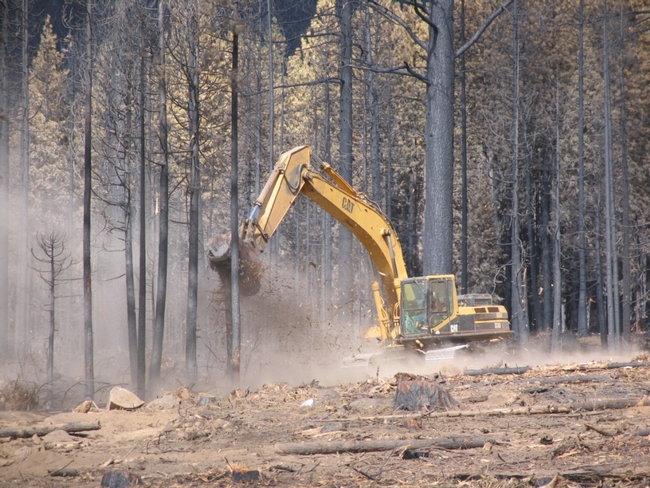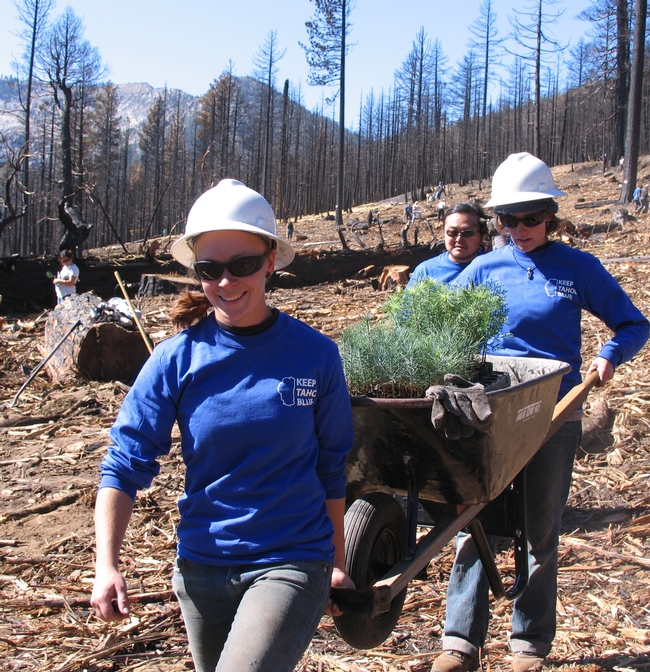Posts Tagged: Tahoe
Forest lands may benefit from active restoration after wildfire
In the many forested areas where wildfires are currently burning, the question will soon arise: What should be done after the fire goes out? That depends on the severity of the burn and land owner goals.
For high severity burns where very few or no live trees remain to provide seed for the next generation, forest recovery can take a very long time. Typically forest landowners want to restore their lands to a forested condition as quickly as possible. In that case, an active approach can help them reach their goal sooner.
The California Tahoe Conservancy has just released a report on the outcomes of active restoration of 40 acres of Conservancy lands where all trees were killed by the 2007 Angora fire in South Lake Tahoe. That fire burned 3,100 forested acres as well as 250 homes.
Post-fire Conservancy goals were to re-establish a native forest, reduce hazards posed by dead trees, and avoid water quality impacts. Contractors cut large dead trees, skidded them to a landing, loaded them on a log truck and sent to a nearby mill. Some large dead trees were left on site to provide wildlife habitat. Small trees were ground up (masticated) and left on site to control erosion and suppress competing vegetation. Then one- to two-year-old native conifer seedlings were planted.
The report's authors estimate this active approach has hastened the return to a forested condition in the area by about 60 years. This is because planted seedlings are growing quickly while there are few naturally sprouting tree seedlings in adjacent untreated areas and these face competition from vigorously growing native brush that was stimulated by the wildfire. Soil monitoring showed no compaction by heavy equipment during tree removal and minimal soil erosion. Woody mulch left on site was also effective at suppressing brush to give newly planted tree seedlings a competitive edge.
Landowners looking for guidance on post-fire forest management are encouraged to download the free UC Cooperative Extension publication “Recovering from Wildfire: A Guide for California Landowners” and consult the UC Center for Forest Research and Outreach website at http://ucanr.edu/forestry.
Lake Tahoe clarity not impaired by Angora Fire
The clarity of the Sierra Nevada's largest alpine lake - Lake Tahoe - was not significantly impaired in the aftermath of the 2007 Angora Fire, according to a story in the Reno Gazette-Journal.
Proactive steps taken by the U.S. Forest Service to reseed the land charred by the fire, which burned 254 homes and blackened 3,000 acres, were credited for helping stave off erosion that could have clouded the lake.
The story was prompted by the release in August of the results of an annual survey of Lake Tahoe clarity by the UC Davis Tahoe Environmental Research Center. TERC reported that the lake was clear to an average depth of 68.1 feet in 2009, holding steady for the ninth year in a row. However, the lake is considerably less clear than it was when researchers first began tracking its clarity in 1968, when it was clear to an average depth of 102.4 feet.
"There was concern that erosion from the (Angora) burn area would get into the lake and cause problems," TERC director Geoff Schladow told the Reno paper. "But we found that the impact from the fire was negligible, which was a great relief for us. All we can say is we may have dodged a bullet on that one."
The newspaper also presented other findings from the 2009 TERC report:
- Invasive quagga mussels were found on 10 boats inspected by Tahoe management agencies as they headed for the lake.
- More precipitation fell as rain and less as snow.
- Algae attached to rocks and docks increased along the northeast shoreline.
- The amount of water-clouding particles and nutrients reaching the lake by west-side streams increased as precipitation rose from previous years.

Lake Tahoe clarity holding steady. (Photo by Roy Tennant, freelargephotos.com)







